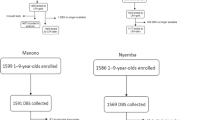Abstract
• Background: Diagnosis of chlamydial conjunctivitis is difficult in chronic diseases because chlamydial elementary bodies are mostly undetectable in conjunctival scrapings by cell culture. We therefore compared two nonculture antigen tests and three different serotests for anti-chlamydial antibodies with McCoy cell culture, the “gold standard” of chlamydial diagnosis. Conjunctival scrapings and serum samples of 93 patients attending the outpatient eye clinic in Graz because of chronic follicular conjunctivitis were tested.
• Methods: A total of 558 conjunctival scrapings and 93 serum samples were investigated. Chlamydial antigen detection was done by McCoy cell culture, polymerase chain reaction (PCR; Amplicor, Roche), and direct immunofluorescence assay (DFA; Microtrak, Syva). Antichlamydial IgA and IgG antibodies in the sera were detected by an immunoperoxidase assay (IPAzyme, Savyon) and two different enzyme-linked immunosorbent assays (SeroELISA, Savyon and rELISA, medac).
• Results: Cell culture and PCR yielded identical results. The positivity rate for chlamydial conjunctivitis was 8.6% (8 of 93 patients). PCR proved most sensitive and most specific. IPAzyme was 75% sensitive for IgA and 100% for IgG; SeroELISA and rELISA were less sensitive. IPAzyme was 81% specific for IgA and 47.3% for IgG. SeroELISA and rELISA were less specific for IgA, but more specific for IgG. Post-test likelihood of disease was greatest in IPAzyme.
• Conclusions: PCR proved to be a good alternative to cell culture; DFA is useful for quick diagnosis. Genus-specific serotests cannot compete with chlamydial antigen detection. They differ in sensitivity and specificity because of the antigen type they present. They are still of only supportive value in cases where chlamydial antigen detection is not possible. Recently introduced species-specific antibody tests should be of greater value.
Similar content being viewed by others
References
Altman DG (1991) Practical statistics for medical research, 1st edn. Chapman and Hall, London, pp 244–258
Anderson AB, Insler MS (1986) Latent ocular manifestations of oculogenital Chlamydia. Ophthalmology 93:67
Auer-Grumbach P, Gogg-Retzer I, Stuenzner D (1991) Die Bedeutung von Serumantikörpern für die Diagnose von chlamydienbedingter Urethritis. Akt Dermatol 17: 174–177
Auer-Grumbach P, Stuenzner D, Haller E-M, Kessler HH, Pierer K, Marth E (1996) Comparison of rapid antigen detection assays and serum antibody tests with cell culture and a polymerase chain reaction assay for the diagnosis of infection with Chlamydia trachomatis. Acta Dermatovenerologica 4:179–184
Bialasiewicz AA, Jahn GJ (1987) Evaluation of diagnostic tools for adult chlamydial keratoconjunctivitis. Ophthalmology 94:532–537
Bialasiewicz AA, Jahn GJ (1989) Chlamydieninfektionen. (Bücherei des Augenarztes, vol 119) Enke, Stuttgart
Blenk H (1993) Genitale Chlamydieninfektionen. Sitzungsbericht der Arbeitsgruppen STD der Paul-Ehrlich-Gesellschaft
Darougar S, Treharne JD, Minassian D, El-Sheikh H, Dines RJ, Jones BR (1978) Rapid serological test for diagnosis of chlamydial ocular infections. Br J Ophthalmol 62:503–508
Dawson C, Thygeson P, Wood R, Jawetz E (1967) Keratitis and other complications in volunteers, infected with inclusion conjunctivitis agents. Rev Int Trach Pathol Ocul Trop Subtrop Sane Publique 1: 7–14
Ehgartner E-M, Faschinger C, Schumann G, Hanselmayer H (1988) Serumantikörper gegen Chlamydia trachomatis bei Patienten ohne chlamydienspezifisches Krankheitsbild. Fortschr Ophthalmol 85:206–209
Ehgartner E-M, Vidic B, Auerbach B, Fellinger Chr, Frieß H-G (1989) Zur Diagnostik von okulären Chlamydieninfektionen. Erfahrungen mit zwei unterschiedlichen Testprinzipien. Klin Monatsbl Augenheilkd 194:156–160
Garland SM, Malatt A, Grando D, Lees MI, Andrew JH, Taylor HR (1992) Chlamydia trachomatis conjunctivis — prevalence and associated genital tract findings. Proc Eur Soc Chlam Res 2:122
Gulletta E, Del Pezzo M, Del Pete A, Covelli I (1990) Laboratory survey of Chlamydia trachomatis ocular infections. Eur J Epidemiol 6:300–303
Haller-Ehgartner E-M, Langmann A, Langman G (1989) Zur Ätiologie chronischer Bindehautentzündungen. Spektr Augenheilkd 3:261–264
Haller E-M, Langmann G, Langmann A, Lerchner H (1991) Persistenz von Chlamydia trachomatis bei Patienten mit chronischer therapieresistenter Konjunktivitis. Fortschr Ophthalmol 88:248–251
Haller E-M, Stuenzner D, Kessler HH, Pierer K, Muellner K, Faulborn J, Marth E (1996) Nachweis von Chlamydia trachomatis in Konjunktival-und Pharyngealabstrichen mittels PCR im Vergleich zu herkömmlichen Methoden. Spektr Augenheilkd 10:28–31
Insler MS, Anderson AB, Murray M (1987) Latent oculogenital infection with Chlamydia trachomatis. Ophthalmology 94:27–29
Jahn GJ (1985) Okulogenitale Chlamydieninfektionen. Grundlagen und Laboraspekte. Klin Monatsbl Augenheilkd 187:235
Kessler HH, Pierer K, Stuenzner D, Auer-Grumbach P, Haller E-M, Marth E (1994) Rapid detection of Chlamydia trachomatis in conjunctival, pharyngeal, and urethral specimens with a new polymerase chain reaction. Sex Transm Dis 21: 191–195
Leinonen M, Ekman M-R, Syrjälä H, Herva E, Saikku P (1990) The etiology of pneumoniae in hospitalized patients during a Chlamydia pneumoniae epidemic in Northern Finland. Seventh Int Symp Human Chlam Infect, Harrison Hot Springs, pp 429–432
Ostler HB (1993) Diseases of the external eye and adnexa. In: Mitchell CW (ed) Williams and Wilkins, Baltimore
Patel HC, Goh PT, Viswalingham MD, Treharne JD (1992) Chlamydia trachomatis antibody response in oculogential infection. Proc Eur Soc Chlam Res 2:90
Ridgway GL (1988) The isolation of Chlamydia spp. in cell culture. Proc Eur Soc Chlam Res 1:227–229
Samara Z, Daye N (1992) Comparison of two methods for detection of antichlamydial antibodies versus culture. Proc Eur Soc Chlam Res 2:229
Schachter J, Cles L, Ray R, Hines PA (1979) Failure of serology in diagnosing chlamydial infections of the female genital tract. J Clin Microbiol 10:647–649
Stenberg K, Mardh PA (1991) Genital infection with Chlamydia trachomatis in patients with chlamydial conjunctivitis: unexplained results. Sex Transm Dis 18:1–4
Stockert K-W, Mahler W, Jakobi E (1992) Okulogenitale Chlamydieninfektionen. Neue Aspekte zu Klinik, Diagnostik und Therapie. In: König B, Keil TU (eds) Fortschritte der Diagnostik 3. Jg. Praxisreport 3. Urban & Vogel, Munich, pp 1–26
Sundmacher R, Harnisch JP, Darougar S, Mattes A, Witschel H, Bredt W (1981) Chlamydienerkrankungen des Auges. Klin Monatsbl Augenheilkd 179:149–156
Sweet RL, Schachter J, Landers DV (1983) Chlamydial infections in obstetrics and gynecology. Clin Obstet Gynecol 26:143–164
Treharne JD, Swyer JStC, Darougar S, Jones BR, Daghfous T (1978) Antichlamydial antibody in tears and sera and serotypes of Chlamydia trachomatis isolated from schoolchildren in southern Tunisia. Br J Ophthalmol 62:509–515
Ward ME (1992) The application of chlamydial immunochemistry to chlamydial diagnosis and sero-epidemiology. Proc Eur Soc Chlam Res 2:47–52
World Health Organization Working Group (1989) Guidelines for the prevention of genital chlamydial infections. WHO report EUR/ICP/CDS 199. World Health Organization, Geneva, Switzerland
Author information
Authors and Affiliations
Rights and permissions
About this article
Cite this article
Haller, EM., Auer-Grumbach, P., Stuenzner, D. et al. Evaluation of two nonculture antigen tests and three serotests for detection of anti-chlamydial antibodies in the diagnosis of ocular chlamydial infections. Graefe's Arch Clin Exp Ophthalmol 234, 510–514 (1996). https://doi.org/10.1007/BF00184860
Received:
Revised:
Accepted:
Issue Date:
DOI: https://doi.org/10.1007/BF00184860




